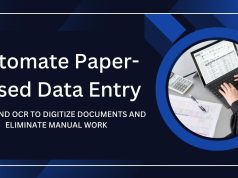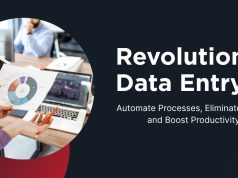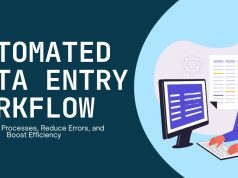Manual data entry is one of those business tasks that feels unavoidable. It’s tedious, time-consuming, and prone to human error, yet it’s essential for keeping your financial records accurate and your vendors happy. Many businesses accept this as a necessary cost of operation, dedicating countless hours and resources to manually keying in information from invoices.
But what if there was a better way? Automating your invoice data entry process can free up your team to focus on more strategic work, reduce costly errors, and provide a clearer, real-time view of your company’s finances. This isn’t a futuristic concept—it’s an accessible solution that can transform your accounts payable workflow.
This guide will walk you through why manual data entry is holding your business back and how you can successfully implement an automated system. We’ll cover the tools, the process, and the significant benefits of making the switch, providing you with a clear roadmap to a more efficient and accurate financial operation.
The Hidden Costs of Manual Data Entry
At first glance, manual data entry might seem like a straightforward task. You receive an invoice, and an employee types the details into your accounting system. Simple, right? The reality is far more complex, and the associated costs—both direct and indirect—can be substantial.

Financial Costs and Inefficiencies
The most obvious cost is the time your employees spend on this repetitive task. Think about the entire manual process: an invoice arrives, it’s sorted, delivered to the right person, manually entered, approved, and finally filed. Each step takes time. Research from the Aberdeen Group has shown that the average cost to process a single invoice manually can range from $12 to $30. For a company processing hundreds or even thousands of invoices a month, these costs add up quickly.
This manual process is also inherently inefficient. It creates bottlenecks, especially when the person responsible for data entry is sick, on vacation, or overwhelmed with other tasks. This can lead to late payments, which can damage vendor relationships and even result in late fees, further increasing costs.
The High Price of Human Error
No matter how diligent your team is, humans make mistakes. A simple typo—an incorrect invoice number, a misplaced decimal point in a payment amount, or a wrong due date—can have significant consequences. These errors can lead to overpayments, underpayments, or duplicate payments.
Correcting these mistakes requires even more time and effort. Your team will have to track down the source of the error, communicate with the vendor, and make the necessary adjustments in your accounting system. These errors not only cost money but also erode the reliability of your financial data, making accurate forecasting and budgeting a challenge.
Negative Impact on Employee Morale
Let’s be honest: manual data entry is not an engaging or fulfilling job. It’s a monotonous, repetitive task that can lead to boredom and burnout. When skilled employees are stuck doing mind-numbing work, their job satisfaction plummets.
This can result in higher employee turnover, which comes with its own set of costs, including recruitment, hiring, and training. By automating data entry, you empower your employees to focus on higher-value activities that require their analytical and strategic skills, leading to greater job satisfaction and a more motivated team.
How to Automate Your Invoice Data Entry
Making the switch from manual to automated invoice processing doesn’t have to be a daunting task. By breaking it down into a series of manageable steps, you can implement a system that saves time, reduces errors, and streamlines your entire accounts payable workflow.

Step 1: Map Your Current Process
Before you can improve your process, you need to understand it completely. Map out every single step of your current invoice data entry workflow, from the moment an invoice arrives to the moment it’s paid and archived.
Identify everyone involved, the tools they use (email, spreadsheets, physical paper), and the time each step takes. This detailed map will reveal bottlenecks, inefficiencies, and areas ripe for improvement. It will also serve as a baseline to measure the success of your new automated system.
Step 2: Choose the Right Automation Tool
With a clear understanding of your current process, you can start looking for the right automation software. There is a wide range of tools available, from simple Optical Character Recognition (OCR) software to comprehensive accounts payable (AP) automation platforms.
Here’s what to look for:
- Optical Character Recognition (OCR): This is the core technology that makes invoice automation possible. OCR scans the invoice document (whether it’s a PDF or a scanned image) and “reads” the text, extracting key information like the vendor name, invoice number, date, and line-item details.
- Integration Capabilities: The tool you choose must integrate seamlessly with your existing accounting software (like QuickBooks, Xero, or NetSuite). This ensures that the extracted data flows directly into your financial system without any need for manual intervention.
- AI and Machine Learning: More advanced tools use AI and machine learning to improve accuracy over time. They can learn to recognize different invoice formats from various vendors, handle exceptions, and even code invoices to the correct general ledger accounts automatically.
- Workflow and Approval Automation: Look for a platform that can automate your approval workflows. You should be able to set up rules to route invoices to the appropriate person for approval based on the amount, department, or vendor.
Step 3: Implement and Test the New System
Once you’ve selected a tool, it’s time for implementation. Start with a pilot program involving a small group of vendors or a specific department. This allows you to test the system in a controlled environment and work out any kinks before a full-scale rollout.
During this phase, provide thorough training to the employees who will be using the new system. Show them how the tool works, how to handle exceptions, and how the new workflow will operate. Collect their feedback to make necessary adjustments.
Step 4: Go Live and Monitor Performance
After a successful pilot, you’re ready to roll out the automated system across the entire organization. Communicate the changes clearly to all relevant staff and vendors. Some vendors may need to be instructed to send their invoices to a specific email address for automated processing.
After going live, continuously monitor the system’s performance. Track key metrics like invoice processing time, error rates, and the number of invoices processed automatically versus those requiring manual intervention. Use this data to refine your process and demonstrate the ROI of the new system to stakeholders.
Transform Your Financial Operations
Automating invoice data entry is more than just a minor process improvement; it’s a strategic move that can have a ripple effect across your entire organization. By eliminating the inefficiencies and errors of manual processing, you unlock significant benefits that contribute to a healthier, more agile business.
Your team, freed from the drudgery of data entry, can focus on value-added activities like financial analysis, vendor relationship management, and strategic planning. This shift not only boosts morale but also transforms your AP department from a cost center into a strategic asset.
If you’re ready to leave the hidden costs and headaches of manual data entry behind, the time to explore automation is now. The technology is accessible, the implementation is straightforward, and the return on investment is undeniable.











